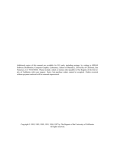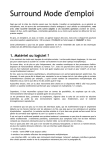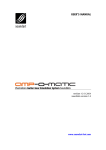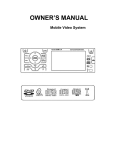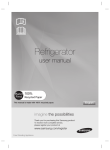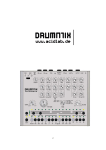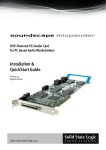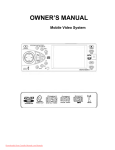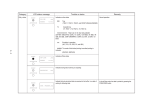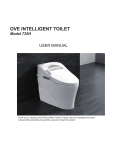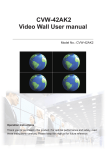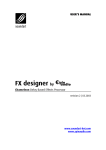Download User guide (V1.0) - Soundart Chameleon
Transcript
USER’S MANUAL Roomverb M1 Chameleon Stereo Reverb Processor revision 2 | 03.2004 soundskin version 1.0 www.soundart-hot.com Copyright © 2001-2003 Soundart www.soundart-hot.com www.spinaudio.com Soundart makes no warranty of any kind, expressed or implied, with respect to the contents or use of the material in this document or in the software and hardware it describes, and specifically disclaims any responsibility for any damages derived from its use. Hardware and Software may contain design defects or errors known as errata which may cause the product to deviate from published specifications. Soundart reserves the right to revise and modify the topics covered in this document periodically, which are subject to change without notice. This document may be reproduced and distributed freely, provided no alterations of any kind are made. Soundart software is subject to the terms of the Soundart Tools Software license. Third party software is subject to the terms of their respective owners license. Third party trademarks and registered trademarks are property of their respective owners. Table of Contents 1 Overview ............................................................................................1 1.1 Main Features ............................................................................1 2 The RoomVerb Concept.......................................................................3 2.1 Virtual Room Modeler ................................................................3 2.2 Reverb Engine............................................................................5 2.2.1 2.2.2 2.2.3 2.2.4 EARLY REFLECTIONS PROCESSOR....................................................................... 6 LATE REFLECTIONS PROCESSOR ......................................................................... 6 TONE CONTROL SYSTEM .................................................................................... 7 MIXER................................................................................................................ 7 3 Preset Mode .......................................................................................9 3.1 Selecting Presets........................................................................9 3.2 Preset Management and MIDI Dumps........................................9 4 Edit Mode .........................................................................................11 4.1 Menu Reference Chart..............................................................11 5 Interface Notes.................................................................................13 5.1 Menu Wrapping .......................................................................13 5.2 Input Configurations ................................................................13 5.3 Clip Indicator............................................................................13 5.4 Bypass Mode............................................................................14 5.5 Edit Lock Mode .........................................................................14 5.6 Preset Loading .........................................................................14 A Loading the Skin...............................................................................15 B Specifications ...................................................................................16 C MIDI Controller Messages .................................................................17 Chapter 11 Overview RoomVerb M1 is a studio-quality true-stereo reverb processor soundskin for the Chameleon. It has been ported to the Soundart Chameleon by Spin Audio, from their respected VST reverb plug-in. It is based on their Virtual Room Acoustic modeling techniques. These allow the Chameleon to simulate a wide variety of acoustic spaces from small bathrooms to large halls using a single set of parameters. Such an approach provides a unified way of controlling reverb and removes the limits inherent in traditional reverb design schemes based on either predefined algorithms or pre-calculated room response patterns. There are tight rooms, clean plates, halls with up 20 second long silky-smooth tails, frequency-dependant decay controls, separate output EQs for the early and late reflections, reverb modulation and a library of 100 ready-to-use presets crafted by working studio sound engineers. Now, the Chameleon can be a high-quality reverb unit too. 1.1 Main Features RoomVerb is designed to produce natural sounding reverberation, but you can also create strange, artificial reverb effects as well. Features include: - Virtual Room Acoustics Modeler with a flexible control of room dimensions, sound source and listener positioning - Acoustic space sizes range from small bathrooms to large halls – from 1m to 50m in each dimension - Room\Hall\Plate simulation - Diffuse control for simulation of irregular room shapes - True Stereo-In Stereo-Out processing - Separate control of Early and Late reflections - Relative L/R Shift control Roomverb M1– User’s Manual 1 2 - Reverb tails up to 20 seconds - Reverb tail modulation - Comprehensive tone control system that includes separate 2-band shelving equalizers for Early and Late reflections - Two-band frequency-dependent decay filters - Level meters - 100 Ready-to-use presets - 28 user-preset locations Main Features Chapter 22 The RoomVerb Concept RoomVerb is based on the idea of simulating a physical reverberation process found in real acoustic spaces by means of a special mathematical model. The process consists of two phases. In the first phase an acoustical image (also called Impulse Response) is calculated based on the geometrical properties of a simulated virtual room - such as dimensions, sound source and recording point positions. In roomverb this takes place in the Virtual Room Modeler. In the second phase the Impulse Response along with other reverb parameters are converted through a special filter to create the sound. In Roomverb this takes place in the Reverb Engine, which uses the data from the first phase to process the incoming audio. 2.1 Virtual Room Modeler Every acoustic space has its own characteristic sound. This can be thought of as a special filter that alters sound sources that are played in this particular acoustic space. If you would like to make your recordings sound as if they are played in a certain acoustic space you just apply the appropriate filter to your data. The properties of this filter that you use can be found either by an actual recording of a space’s response to a click-like signal, or by means of a mathematical model. RoomVerb uses the latter approach. The filter properties are calculated in the Virtual Room Modeler, and passed to the Reverb engine for processing. The modelling is based on the geometrical properties of a simulated acoustic space. Although every acoustic space has a different geometry, all the complexity can be reduced down to four fundamental parameters: The three dimensions and the number of reflective surfaces. In RoomVerb, dimensions are set for the room's width, depth and height [ROOM\Dimensions]. These parameters are totally independent, thus you can design spaces like long tunnels and deep wells. Dimensions can vary from 1 to 50 meters allowing you to model a small phone booth as easily as a large hall. Roomverb M1– User’s Manual 3 Besides three-dimensional spaces Roomverb can also model 2-dimensional spaces - you may think of them as plate reverbs. The plate reverb mode is turned on simply when you set a room's height to minimum - to zero value. The above parameters determine only common spatial properties. In order to calculate an actual impulse response there should be virtual sound source and two recording points for a stereo result. In Roomberb, the positions of the sound source and the stereo record points are set in relation to a line connecting the middle points of the front and back walls. The controls for this are found in the pages Src-Lst (source listener): - The ‘distance’ control [ROOM\Src-List\Dist] sets up the distance between the srouce and record points and is limited by room's depth. - The distance between the stereo recording points themsleves is set by ‘L-R dist’ [ROOM\Src-List\L-R Dist] and is limited by the room's width. The geometrical model described above produces a reverberation that corresponds to a totally rectangular room with six plain surfaces. This will sound nice and ‘pure’, but it will probably also sound relatively boring. Such rooms have a lot of completely regular reflection patterns due to the total symmetry of room and lack of other reflective surfaces. Luckily there are special mathematical models that allow us to simulate reverberation patterns of more ‘natural’ rooms using this rectangular room model as a handy reference. The main factor that makes a room sound ‘natural’ is the other reflective surfaces and how they are placed in relation to each other. Sound waves propagating in a real acoustic space with a lot of reflective surfaces tend to bounce much more chaotically, which reduces the amount of stereo correletions between the reflections. A large part of our ability to navigate the world uses our ears for spatial awareness (more than we often realise), and so the human brain is very sensitive to spatial reverb correlation. A more ‘natural’ and more chaotic model in an artificial reverb is frequently connected to such perceivable psyco-acoustic parameters as ‘spaciousness and fullness’. In order to simulate such spaces RoomVerb has a parameter that increases the number of other reflective surfaces in the simulated room and thus reduces the correletion between left and right recording points. This parameter is called ‘Stereo Image Width’ [ROOM\Misc\StereoImg] because its main effect is perceived as increasing of stereo image width. So far we have been describing the virtual room geometrically. However, there is one parameter in the modeller that does not correspond to geometrical properties of acoustic space. This is the wall’s ‘absorption’ [ROOM\Misc\Absorb]. This parameter determines an amount of sound energy absorbed by room surfaces. The higher the value, the faster sound reflections decay in volume with the number of progressive reflections. 4 Virtual Room Modeler NOTE: Any change made to Virtual Room parameters causes RoomVerb to recalculate the Impulse Response for the reverb engine, which takes about one second to complete. During this time there is an hour glass icon displayed in the right corder of the Chameleon LCD display. 2.2 Reverb Engine The Roomverb Reverb Engine is the block that actually processes incoming audio signal using the data provided by the Virtual Room Modeler. It uses the data to build the Early and Late reflections, along with using its own set of parameters to shape the sound, such as EQs. The Reverb Engine has 4 functional parts: - Early Reflections processor – initial reflections - Late Reflections processor – the ‘tail’ of the reverb - Tone control system – for adjusting the ‘colour’ - Mixer – for mixing all this together And so the output sound of RoomVerb is made up of three different signals: - The Dry, non-processed signal, corresponding to the sound that comes to the listener directly from a sound source without being reflected from any of the walls; - Early Reflections, which are rays reflected once or twice from the Virtual Room’s walls before reaching the listener; - Late Reflections, or so-called 'reverberation,' that correspond to the sound rays reflected many times from the Virtual Room walls, making a diffuse ‘reverb tail’. The early reflections give us information about the room size and shape. The late reflections mostly provide 'a feel of a room', or to put it another way, they provide spectral characteristics of a room - bright, dark, dull, metallic etc. In natural rooms late reflections decay exponentially. The time it takes for the level of these late reflections to drop down to -60dB is called the reverberation time. Reverberation time is the second factor that gives the information about room size along with Early reflections. For instance, imagine if you were blindfolded and led into a large, stone cathedral, and then you clapped your hands loudly. Firstly, the early reflections would take a relatively long time to bounce off the large solid walls and back to you again, eg up to around 100ms. Next, the late reflections would take maybe up to 15 seconds to decay, and so even with your eyes closed you would be able to tell straight away that you are standing in an extremely large space with very hard walls. This is a good Roomverb M1– User’s Manual 5 example of a distinctive acoustic space that can be recreated in using a digital reverb like Roomverb. 2.2.1 EARLY REFLECTIONS PROCESSOR The Early Reflections processor uses the Impulse Response data of a virtual room which is calculated by the Virtual Room Modeler block. There is only one parameter - Pre-delay [REVERB\Early\Predelay]. Pre-delay allows you to introduce additional time shift between direct sound (dry signal) and Early reflections. Note that there is already a delay incorporated into the calculated Early reflections pattern that corresponds to the virtual room dimensions. So use this parameter for producing artificial effects. 2.2.2 LATE REFLECTIONS PROCESSOR The Late Reflections processor produces the diffuse reverberant field that is also known as the ‘tail’ of the reverb. Like the early reflections it also uses the Impulse Response calculated by the Virtual Room Modeler block, though in a different way. It has three sections: Impulse Response related controls, Decay and Modulation. 2.2.2.1 L/R Impulse Response Related Controls The controls in this section determine how the Impulse Response data is used by reverb engine to create the late reflections. The pre-delay parameter [REVERB\Late\Predelay] sets a time delay between direct sound (dry signal) and Late reflections. Note that the LR pre-delay has nothing to do with ER pre-delay - they are completely independent. Pre-delay is necessary to separate the direct sound, the Early and the Late reflections in time. To get a naturally sounding reverberation you should set pre-delay according to room size - the bigger size the more pre-delay should be set. Offset is a unique RoomVerb parameter not found in any other reverbs [ROOM\Misc\LR Shift]. Offset defines the starting point in the calculated Impulse Response provided by the Virtual Room Modeler block that is to be used for Late reflections. Note that this offset time is not added to reverb as an additional delay. The effect of changing offset can be described as a type of *diffusion* because the time differences between near reflections in the Impulse Response decrease with a time, so reflections become denser. 2.2.2.2 Reverb Decay Controls The Reverb Tail Decay controls allow you to specify how the reverb decays at different frequencies. You may think of it as controlling a *feel* of a simulated acoustic space. 6 Reverb Engine Sound waves gradually lose a part of their energy as they travel around in real acoustic spaces. The energy is absorbed by air and reflective surfaces. The amount of absorbed energy changes at different frequencies. Air damps high frequencies as do many materials from which the reflective surfaces are commonly made. This means that the reverb tail has different decay (or you may say reverberation) times at different frequencies. In a typical room higher frequencies decay faster. To simulate different reverb tail dacay times at different frequencies Roomverb offers a special damping filter. The damping filter consists of two equalizer filters: Low Shelving EQ and High Shelving EQ [REVERB group]. The gains of the filters are displayed in reverb time multiplier scale so you can easily figure out the actual reverberation time at a given frequency by multiplying the overall reverb time [REVERB\Late\RevTime] to the multiplier. 2.2.2.3 Reverb Modulation Modulation allows to add dynamic and *live* feel into reverb tail. In real rooms this is caused by fluctuations and micro variations that are always present in the air, adding some subtle dynamic movements into the sound of an acoustic space. This can be simulated by using a special modulation technique. Roomverb offers 6 different pre-defined modulation types [REVERB\Late\ModType] that differ in their modulation depths, rates and stereo image widths. This simple modulation works best in mid-sized rooms on melodic instruments such as pianos. Note however that it should be used carefully, as medium and deep modulation types may produce unnatural pitch-shifted reverb tails on melodic instruments. 2.2.3 TONE CONTROL SYSTEM The tone control system allows to change frequency content of Early and Late reflections before they are mixed together at the Chameleon’s output. It consists of two independent 2-band equalizers for the Early and Late reflections respectively [MASTER\*Shf]. Each equalizer has two filters: Low Shelving EQ and High Shelving EQ, with controllable mid-point frequency, gain and slope. Using these EQ’s you can shape the colour and tone of the reverb quite dramatically. 2.2.4 MIXER The mixer is the Roomverb block that mixes the Dry signal with the Early and Late reflections for the Chameleon stereo output. It also allows you to adjust the level of the input signals [MASTER\Gain\In]. The mixing proportions are set by three parameters: wet/dry balance, ER gain and LR gain. These are very important parameters as the proportions Roomverb M1– User’s Manual 7 between the dry signal, early and late reflections greatly affect the sound and spatial feel of the reverb. Basically the wet/dry balance is used to set a perceptual distance of a sound in a mix. The more reverb and less original signal, the further away sound source is perceived to be by our ears. ER and LR gains allow you to control a balance between the definite (ER) and the diffuse (LR) parts of the reverb. Note: if you set up RoomVerb as an auxilliary send on your mixing desk you should set the wet/dry value to 100%. This is because you can set the wet/dry mix yourself using the aux return level on your desk. 8 Reverb Engine Chapter 33 Preset Mode From here on we now describe how to control Roomverb from the front panel of the Chameleon. Preset Mode is the default start-up mode when you turn on the Chameleon with Roomverb loaded. It will show the first preset and you can choose a reverb from there. 3.1 Selecting Presets In preset mode you can choose between the various stored presets using the big dial or the VALUE keys. These have been carefully crafted for ease of use and practical studio applications. 3.2 Preset Management and MIDI Dumps Also from this mode, you can perform MIDI dumps of your presets to a sequencer and reload the factory sets should you wish to. To make a MIDI dump of internal settings before switching to another soundskin, press GROUP UP. There you can use VALUE UP and DOWN to cycle between the MIDI dump options, and EDIT to execute. The MIDI data will be sent out of the MIDI OUT, and you simply have your MIDI sequencer recording the data. Table 3-1 Group MIDI DUMP Page Parameter Value Full bank Current preset Alternatively, from preset mode you can press GROUP DOWN to take you to the preset manager where you can reload the factory defaults all together or individually. You can also select default preset to load a ‘blank’ preset for starting from scratch. You press EDIT to execute. Warning – be careful that you are not wiping over all your precious presets that you have created! Loading the full factory bank will repace ALL your presets with the original settings created by us. Roomverb M1– User’s Manual 9 Table 3-2 Group Page PRESET MANAGER 10 Parameter Value Default preset Factory preset Factory bank Preset Management and MIDI Dumps Chapter 44 Edit Mode To enter edit mode to change the parameters of a preset, press the EDIT key. From here, the menus change to show you all the available parameters for creating your own presets. 4.1 Menu Reference Chart Roomverb M1 has the following editable parameters, laid out below using the standard GROUP, PAGE, PARAMETER and VALUE hierarchy (these have been described in detail in the previous chapters): Table 4-1 Group MASTER Page Gain ER Lshelf ER Hshelf Freq Gain Slope Status LR Lshelf Freq Gain Slope Status LR Hshelf Freq Gain Slope Status Input Roomverb M1– User’s Manual Parameter Wet/Dry Early Late IN Freq Gain Slope Status Value 1…100% -96dB…0dB -96dB…0dB -96dB…0dB 50…20,000Hz -20dB…+12dB 0.100…1.000 ON OFF 50…20,000Hz -20dB…+12dB 0.100…1.000 ON OFF 50…20,000Hz -20dB…+12dB 0.100…1.000 ON OFF 50…20,000Hz -20dB…+12dB 0.100…1.000 ON OFF STEREO LEFT RIGHT 11 Group ROOM Page Dimensions Src-Lst Misc. REVERB CONFIG Early Late Lo shelf Freq Gain Slope Status Hi shelf Freq Gain Slope Status Input MIDI MONITOR Parameter Width Depth Height Distance Height L/R Dist Stereo Image L/R Shift Absorb PreDelay PreDelay RevTime ModType MIDI Channel MIDI Thru Input Output MIDI ID (view meters) (view meters) In Dry Wet Early Late 12 Value 0.01…50m 0.01…50m 0.01…50m 0.01…50m 0.01…50m 0.01…50m 0.00…1.00 0…100% 0.00…1.00 0…200ms 0…200ms 0.20…20.00sec NONE LIGHT M LIGHT S MED M MED S DEEP M DEEP S 50…20,000Hz 0.1…1.0 0.100…1.000 ON OFF 50…20,000Hz 0.1…1.0 0.100…1.000 ON OFF STEREO LEFT RIGHT DUAL 1…16 ON OFF 1…128 ON MUTE SOLO ON MUTE SOLO ON MUTE SOLO ON MUTE SOLO ON MUTE Menu Reference Chart Chapter 55 Interface Notes Some further notes on the particular Roomverb interface. 5.1 Menu Wrapping All menus in Edit mode wrap around as you go through the options, to speed up the editing process. 5.2 Input Configurations RoomVerb supports four audio input configurations: - Stereo - Stereo to Stereo. Use this for stereo input signals - Left/Right - Left/Right to Stereo. Use it if you have a mono input signal at either the left or right input - Dual - Dual Send mode. Use this configuration if you would like to process two mono sends from your mixer Note that Input config is a global parameter and is not saved with the preset. 5.3 Clip Indicator As well as using the horizontal stereo level meters in the Monitor section of edit mode to see the input levels, RoomVerb can detect clipping of input and output signals in Presets mode. If clipping occurs there is an [c] icon displayed for a second in right corner of the Chameleon LCD display. To find out the source of clipping you should switch to edit mode to browse to Monitor section. Roomverb M1– User’s Manual 13 5.4 Bypass Mode You can switch RoomVerb into bypass mode by pressing the PART-DOWN button on the Chameleon unit. When bypass mode is active there is a [B] icon displayed in the right corner of the LCD display in Preset mode and the SHIFT LED is on in Edit mode. 5.5 Edit Lock Mode You can switch RoomVerb into Edit Locking mode to protect your current reverb state from accident changing during gigs. To switch to the Edit Lock mode press PART-UP button on the Chameleon unit. When Edit Lock mode is active there is a [L] icon displayed in the right corner of the LCD display in Preset mode and the EDIT LED is on in the Edit mode. 5.6 Preset Loading Every time you select a new preset it is loaded into the Chameleon DSP engine. This operation requires about one second to complete. During this time there is an hour glass icon displayed in the right corner of the Chameleon LCD display. 14 Bypass Mode Appendix AA Loading the Skin RoomVerb M1 skin is contained into a MIDI file called “roomverbM1_vXX.mid” (where XX is the current version of the skin). Like any other Chameleon skin, you have to take care with the user data stored in the existing skin before downloading Roomverb M1. If you have an older version of RoomVerb M1 installed in your Chameleon, your existing presets and configuration will be properly updated to the new version once you download it, so it’s not mandatory to make a backup of them (although it is always recommended). If you have a different skin installed in your Chameleon, you may lose your data if you don’t make a backup of it before. You should always make a MIDI dump of your user data before changing skin. See the manual of the coressponding skin for more details. Once the skin is loaded, it is ready to use. By default, the skin comes with all the presets set to the default state. Before to start editing presets as described, you may want to take a quick overview of the built in presets to discover the skin’s features and possibilities. Roomverb M1– User’s Manual 15 Appendix BB 16 Specifications Effect Class: Reverb Short Description: Virtual Room Modelling Reverb Hardware Platform: Soundart Chameleon Automation: MIDI Automation Presets: 100 Sample Rate: 48 kHz Processing Precision: 24 bit fixed point Input/Output Format: mono/stereo, stereo/stereo, dual-send Max reverb Time: 20 seconds Specifications Appendix CC CC MIDI Controller Messages 2 3 4 5 6 7 8 9 Parameter Wet/Dry Mix Early Reflections Level Late Reflections Level Input gain Mute/Solo Dry Mute/Solo Wet Mute/Solo Early Reflections Mute/Solo Late Reflections 12 13 14 15 16 17 18 19 20 21 22 23 24 25 26 27 28 29 30 31 Mute/Solo Input Early Reflections Output Low Shelving EQ Mid-point Frequency Early Reflections Output Low Shelving EQ Gain Early Reflections Output Low Shelving EQ Slope Early Reflections Output Low Shelving EQ On/Off Early Reflections Output High Shelving EQ Mid-point Frequency Early Reflections Output High Shelving EQ Gain Early Reflections Output High Shelving EQ Slope Early Reflections Output High Shelving EQ On/Off Late Reflections Output Low Shelving EQ Mid-point Frequency Late Reflections Output Low Shelving EQ Gain Late Reflections Output Low Shelving EQ Slope Late Reflections Output Low Shelving EQ On/Off Late Reflections Output High Shelving EQ Mid-point Frequency Late Reflections Output High Shelving EQ Gain Late Reflections Output High Shelving EQ Slope Late Reflections Output High Shelving EQ On/Off Reverb Decay Low Shelving Filter Mid-point Frequency Reverb Decay Low Shelving Filter Gain Reverb Decay Low Shelving Filter Slope 33 34 35 36 37 38 39 40 41 42 43 44 45 46 Reverb Decay Low Shelving Filter On/Off Reverb Decay High Shelving Filter Mid-point Frequency Reverb Decay High Shelving Filter Gain Reverb Decay High Shelving Filter Slope Reverb Decay High Shelving Filter On/Off Early Reflections Pre-delay Late Reflections Pre-delay Reverberation Time Reverb Modulation Type Inter-microphones distance Virtual Room Width Virtual Room Depth Virtual Room Height Source to Listener Distance Roomverb M1– User’s Manual 17 CC 47 48 51 52 53 18 Parameter Source/Listener Height Stereo Width Late Reflections Impulse Response Shift Walls Absorption Input Config MIDI Controller Messages






















